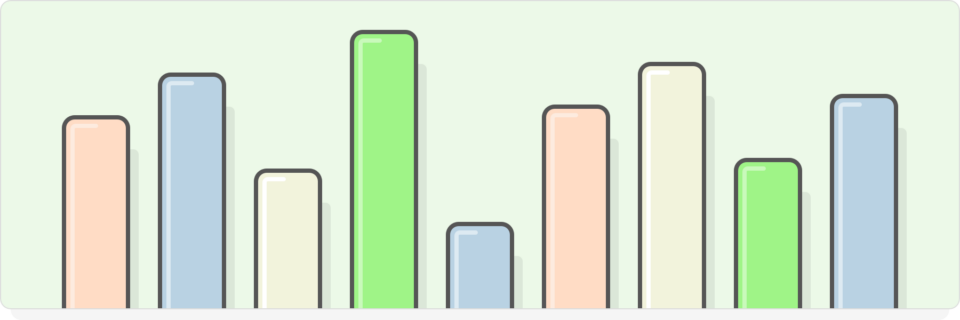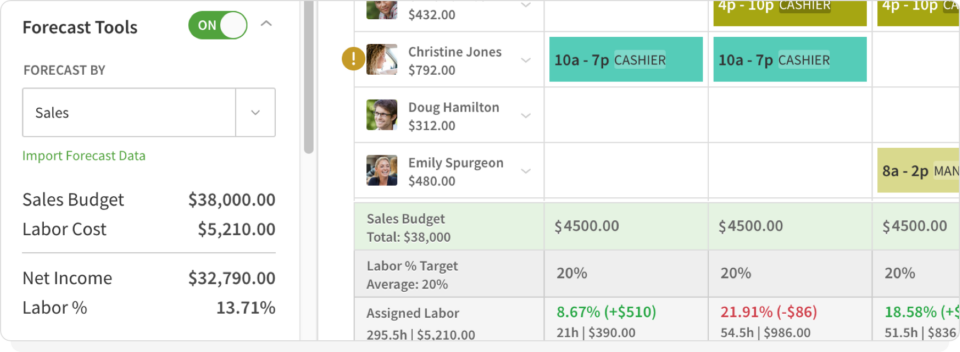What Is Labor Forecasting? Definition, Examples, & More
Try When I Work for free
As a manager, one of your biggest challenges involves ensuring you have enough people at work to keep things running smoothly. That’s easier said than done. If you don’t schedule enough workers, your shift will be overwhelmed. Too many employees, and you’re paying for idle time. That’s why performing labor forecasting is so beneficial.
Labor forecasting can help you make smarter staffing decisions and reduce costs. Sound complicated? It doesn’t have to be, thanks to tools like When I Work. Try our platform for free and see how easy it is to predict your labor needs.
Key takeaways:
- Understaffing can lead to burnout and poor productivity
- Overstaffing hurts your bottom line and leads to bloated payroll costs
- There are several different ways to estimate labor needs
- The best approach involves using employee scheduling tools
- These tools can automate forecasting, shift optimization, and more
Table of contents:
- What is labor forecasting?
- What are the benefits of labor forecasting?
- Methods of labor forecasting
- Real-world examples
- How employee scheduling software can help you forecast labor needs
- Labor forecasting made easy with When I Work
What is labor forecasting?
Labor forecasting involves predicting how many workers you’ll need to staff a future shift. You’ll need to use historical data about past staffing levels and customer demand to determine upcoming labor needs. Labor forecasting helps you avoid over- or under-scheduling.
There are several ways to forecast your labor needs. One simple approach involves the following formula:
Labor forecast = (Projected sales / sales per hour) x average hourly wage
This formula helps estimate the number of hours you’ll need to staff based on expected sales and your team’s productivity rate. Labor forecasting is about making the most of your resources while keeping payroll costs down.
What are the benefits of labor forecasting?
Here’s a glimpse at the benefits your business can unlock by forecasting its labor needs.
Improved efficiency
Labor forecasting helps you make the most of your available workforce. Let’s say your base schedule calls for the following staffing levels:
- 8 workers for weekday morning shifts
- 8 workers for weekday evening shifts
- 10 workers for weekend shifts
However, your forecast reveals that the weekday morning shifts have been a lot slower. On the other hand, your weekend shifts have been slammed. You could use this information to predict that labor demand will be lower on weekday mornings and higher on Saturdays and Sundays.
Without forecasting, you might just assume you need to hire a couple more weekend workers. In reality, you can avoid the extra payroll expense and simply pull a few people from the slow weekday morning shift.
Decreased labor costs
Labor forecasting can help you slash labor costs. If you know how many people you need for each shift, you can avoid overstaffing. You’ll also be able to minimize overtime or unplanned staffing expenses.
Let’s say you have 16 unnecessary labor hours each week due to overstaffing. In this scenario, those workers average about $20 per hour. That means you are taking on $320 per week of unnecessary payroll expenses. Labor forecasting could save you thousands of dollars over the course of the year by avoiding this mistake.
Better employee satisfaction
No one wants to work shorthanded. When you don’t put enough people on the schedule, those who are working have to pick up the slack. The extra work can lead to burnout. Labor forecasting helps minimize the risk of understaffing a shift.
When you accurately predict staffing needs, you can create more consistent schedules for your staff. They will have a good idea of when they will be working. This will lead to better job satisfaction.
Happier customers
Customers are the lifeblood of your business. They expect prompt, friendly service. You need to provide service in accordance with their expectations. Frequent understaffing can delay service and hurt your reputation. A particularly bad experience could even cost you a once loyal customer.
Your team members will struggle to provide a great experience if they are overloaded with work. Labor forecasting helps ensure the workload is evenly distributed. This means your employees won’t be so overwhelmed and can give each customer the attention they deserve.
Methods of labor forecasting
There are several ways to forecast your labor needs. Each method has its own advantages. Here’s a look at three popular options you should consider using.
Historical analysis
One of the simplest methods is historical analytics. You’ll need to look at your past staffing needs during similar times and events to predict future demand. Let’s say your business usually sees a 20% spike in demand during the holiday season. Use this data to figure out how many extra team members you’ll need this year.
Historical analysis is a reliable method, especially if your business experiences seasonal fluctuation. Look back at data from previous years. Use this information to identify trends and adjust your staffing accordingly.
Delphi method
The Delphi method involves gathering input from key stakeholders or business leaders. Each person can provide unique insights about staffing needs. The goal is to reach a consensus.
Who should be a part of your panel? That depends on the size and composition of your business. Participants may include department managers, the HR director, and team leads. You’ll want to include people from different levels of the business so you can obtain several perspectives. Each expert should provide their estimates for future labor needs based on their experience. Everyone will get together and discuss their predictions until all of you agree on how to staff the business.
Market research
Market research involves gathering information about trends in your industry and external factors that might influence your labor needs. Let’s say you own a retail store. You may need to analyze customer spending trends. You could also study how economic conditions are affecting sales.
Doing market research allows you to make more informed decisions about how many employees you’ll need. This is one of the most complex methods of labor forecasting. It can also be invaluable when you work in a dynamic industry.
Real-world examples of labor forecasting
The best way to understand labor forecasting is to look at real-world examples. Here are a few practical scenarios that show the value of forecasting labor needs.
Restaurant preps for busy season
Restaurants are accustomed to seasonal fluctuations. Labor forecasting helps them adapt. Imagine you own a local restaurant. You typically get slammed every December. Based on previous years, you notice that your average daily customer count increases by about 30%. You’ve learned this from tracing past sales and knowing how many people came through the doors in previous years.
You decide to hire a few extra seasonal staff to prepare for the rush. You also adjust employee’s schedules to make sure more people are working during peak hours. This means you won’t have to rely on last-minute overtime or risk working short-handed.
The extra staff gives you the cushion necessary to keep the business running smoothly. Customers are happy. Service is prompt, and your restaurant protects its reputation as the go-to December dining establishment.
Retail store gears up for a big product launch
Retail stores can also benefit from labor forecasting. Let’s say you manage a retail store and are about to launch a hot new product. You expect it to bring in a ton of business. However, this isn’t your first product launch.
Being a savvy retail manager, you know that the Delphi Method will be the best forecast model for your business. You meet with key stakeholders, including your sales manager, customer service team leader, and inventory supervisor. Together, the four of you come up with an accurate labor forecast based on past product launches.
You decide that hiring temporary staff for a one-month rush doesn’t make much sense for your team. Instead, you incorporate some overtime expenses into your budget for the month following the product launch. You and the other salaried managers adjust your work hours to jump in and help the hourly employees. By budgeting for some overtime and stepping up as a leader, you set the stage for a successful product launch.
How employee scheduling software can help you forecast labor needs

When I Work employee scheduling software provides a visual breakdown of staffing needs and upcoming schedules. It makes it easy to figure out how many people to put on the schedule.
Labor forecasting made easy with When I Work

When I Work is jam-packed with handy tools to simplify workforce management. Our team messaging app makes it easy to securely communicate with your team members. The time clock provides a real-time glimpse into current labor expenses based on each person’s hours worked.
Sign up for a free trial of When I Work. Let our platform simplify labor forecasting so you can keep your business adequately staffed and come through for customers.






